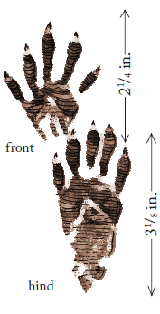Wildlife - Species

Species Specific Regulations
Raccoon
Licenses:Hunting License required.
Limits: Weapon restrictions according to game zones please check for Limitations.
Hunting regulations
Raccoon (Procyon lotor)

Raccoon track
Description
It has a conspicuous black mask, and the furred tail is marked with alternating black and gray rings.
The raccoon stands 9 to 10 inches at the shoulder and weighs 6 to 12 lbs.
Life Expectancy
The oldest recorded wild raccoon in the state was 13 years old.
Preferred Habitat
Raccoons occupy a variety of habitats but are mostly associated with aquatic areas. Raccoons are common in the coastal marshes and in bottomland hardwoods. Swamps with mature hardwood timber are preferred because of the availability of food and den trees. Other important areas are wooded streams flowing through agricultural areas and beaver ponds. The conversion of hardwoods to monoculture pines, the destruction of streamside timber, and development of coastal islands have reduced raccoon numbers in some areas.
Range
Raccoons exist throughout the United States except in desert areas. They occur statewide in South Carolina. Populations are highest along the coast and decline steadily inland.
Food Habits
Raccoons commonly feed on crayfish, clams, frogs, salamanders, snails, and turtles. They are infamous predators of bird nests, particularly waterfowl. The diet also includes a wide variety of plant foods including acorns, berries, and wild grapes. During the winter months acorns may compose as much as 50% of the diet. During certain seasons of the year raccoons invade agricultural fields to feed on corn, watermelons, and peanuts and can cause some damage. Raccoons will scavenge on carrion and often invade household garbage.
Reproduction
Peak Breeding Activity
Raccoons are polygamous, breeding mostly in January and February.
The young stay in the den for about 3 months, then accompany the mother in her activities. The family usually breaks up in late fall.
Gestation
63 days and the average litter size is 2 to 4 in the South.
Miscellaneous
Canine distemper plays a major role in controlling raccoon populations. Rabies limits numbers in some areas. They are sometimes limited by the availability of den trees and food, especially local acorn production. The annual mortality rate in South Carolina is estimated at 35%.
The raccoon is greatly abundant and is the most commonly commercialized furbearer in the state. South Carolina supports a relatively high raccoon population that provides a lot of recreation for sportsmen. Trapping for raccoons is common throughout the state, with the most highly valued raccoons coming from the Piedmont and Mountain regions where the pelts are darker and fuller. In the Coastal Plain, raccoon pelts take on a reddish or yellow tinge, which lowers their value. Raccoons are also hunted at night with hounds. While the raccoon has a valuable pelt, a large number of hunters pursue the raccoon entirely for sport without intentions of harvesting their quarry. Competition among hunts over the best “coondog” is intense, and numerous clubs exist in the state to hold competitive raccoon hunting events. Though populations statewide are high, local populations may fluctuate because of distemper outbreaks and annual weather conditions that affect acorn production.
Publications and Literature
Baker, O.E., Carmichael, D. Breck, South Carolina Furbearers. Wildlife and Freshwater Fisheries Division. Columbia, South Carolina
The Impact of Sport Raccoon Hunting on Deer Movement and Deer Hunting Sucess. (Adobe PDF) Wildlife and Freshwater Fisheries Division. Columbia, South Carolina.
Fur Harvest Hunting and Trapping are provided in the Fur Harvest Brochure which is a summary of the state statutes regarding the commercial harvest of furbearers. Applicable statutes are listed in parentheses at the end of each section of this brochure. Copies of actual statutes of the SC Code of Laws are available online from the SC Legislature at www.scstatehouse.gov or by writing: Furbearer Program, SC Department of Natural Resources, P.O. Box 167, Columbia, SC 29202.
Some of the files above are provided in the Adobe® Acrobat® (PDF) format. Adobe® Reader® is required to open these files and is available as a free download from the Adobe® Web site.
Jay Butfiloski - Furbearer Project Supervisor
SCDNR Furbearer Project
P. O. Box 167
Columbia, SC 29202-0167
Phone: 803-734-3886
Fax: 803-734-6020
E-mail: ButfiloskiJ@dnr.sc.gov

